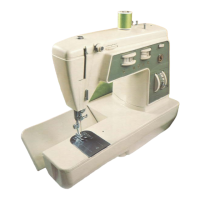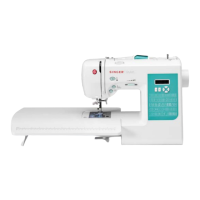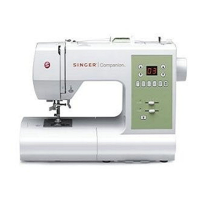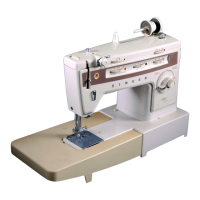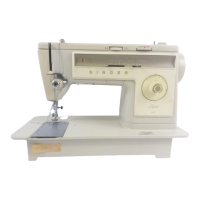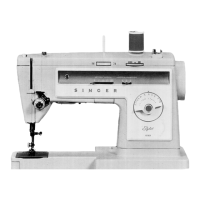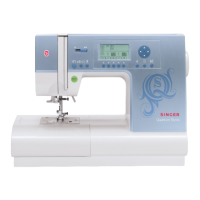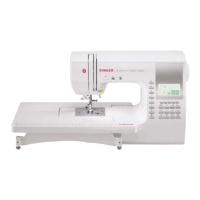Do you have a question about the Singer Stylist 776 and is the answer not in the manual?
Explains the function of each numbered part of the sewing machine.
Lists and describes the accessories included with the sewing machine.
Details initial steps before sewing: connecting the machine and operating controls.
Guides selection of appropriate needle and thread based on fabric type.
Step-by-step instructions for threading the sewing machine and winding the bobbin.
Instructions on preparing the machine and beginning straight stitching with correct dial settings.
Guidance on adjusting stitch length, pressure, and thread tension for optimal fabric stitching.
Guidance on pin basting, fabric placement, guiding, turning corners, and starting seams.
Introduces basic and Flexi-Stitch patterns, detailing dial settings for various stitches.
Explains setting pattern, needle position, and stitch width dials for zig-zag stitching.
Details adjusting stitch width, needle-thread tension, and stitch length for zig-zag stitches.
Provides specific dial settings and adjustments for achieving satin stitching.
Charts stitch patterns and corresponding dial settings for twin-needle stitching.
Step-by-step instructions for inserting a twin needle.
Details threading process required for twin-needle stitching.
Outlines dial settings for straight and zig-zag twin-needle stitching.
Explains executing square corners with a twin needle for decorative designs.
Explains speed basting for temporary seams and provides procedural steps.
Details thread tension and preparation for effective machine basting.
Instructions for sewing buttons onto fabric using the machine.
Covers buttonhole styles, proper placement, and determining correct length.
Discusses interfacing, test buttonholes, and cutting buttonhole openings.
Details dial settings and procedure for creating round-end buttonholes.
Explains settings and procedure for creating bar-tack buttonholes.
Instructions for flower embroidery using free-motion stitching, including preparation and techniques.
Explains attaching the zipper foot for sewing zippers close to the edge.
Guides creating and attaching welting to form corded seams.
Demonstrates making regular darts and darts in interfacing for a neat finish.
Instructions for blindstitch hems and finishing seam edges in ravel-prone fabrics.
Guidance on sewing knit, stretch, and challenging fabrics like vinyl and velvet.
Introduces decorative techniques like topstitching, monograms, borders, and appliqué.
Outlines smocking procedures and drawn-thread work techniques for decorative effects.
Covers techniques for mending tears, blanket binding, repairing seams, and darning.
Instructions on converting the sewing machine to free-arm sewing mode.
Shows how free-arm sewing simplifies stitching buttonholes and buttons on cuffs/neckbands.
Demonstrates free-arm sewing for topstitching sleeves and attaching emblems.
Explains how free-arm sewing facilitates finishing circular garment areas like sleeves and pant legs.
Shows how free-arm sewing makes darning and mending accessible for various garment areas.
Illustrates applying bar tacks to garment details using the free-arm surface to manage fabric bulk.
Provides instructions for cleaning the sewing machine with a soft cloth and brush.
Details removing and replacing the top cover, bottom cover, bobbin case, and light bulb.
Step-by-step guide for removing the bobbin case for cleaning or replacement.
Instructions for re-engaging and replacing the slide plate if dislodged.
Step-by-step instructions for safely changing the sewing machine's light bulb.
A checklist to diagnose common sewing problems like thread breaks or fabric feeding issues.
Lists and describes various optional sewing machine accessories for specialized tasks.
Explains the function of each numbered part of the sewing machine.
Lists and describes the accessories included with the sewing machine.
Details initial steps before sewing: connecting the machine and operating controls.
Guides selection of appropriate needle and thread based on fabric type.
Step-by-step instructions for threading the sewing machine and winding the bobbin.
Instructions on preparing the machine and beginning straight stitching with correct dial settings.
Guidance on adjusting stitch length, pressure, and thread tension for optimal fabric stitching.
Guidance on pin basting, fabric placement, guiding, turning corners, and starting seams.
Introduces basic and Flexi-Stitch patterns, detailing dial settings for various stitches.
Explains setting pattern, needle position, and stitch width dials for zig-zag stitching.
Details adjusting stitch width, needle-thread tension, and stitch length for zig-zag stitches.
Provides specific dial settings and adjustments for achieving satin stitching.
Charts stitch patterns and corresponding dial settings for twin-needle stitching.
Step-by-step instructions for inserting a twin needle.
Details threading process required for twin-needle stitching.
Outlines dial settings for straight and zig-zag twin-needle stitching.
Explains executing square corners with a twin needle for decorative designs.
Explains speed basting for temporary seams and provides procedural steps.
Details thread tension and preparation for effective machine basting.
Instructions for sewing buttons onto fabric using the machine.
Covers buttonhole styles, proper placement, and determining correct length.
Discusses interfacing, test buttonholes, and cutting buttonhole openings.
Details dial settings and procedure for creating round-end buttonholes.
Explains settings and procedure for creating bar-tack buttonholes.
Instructions for flower embroidery using free-motion stitching, including preparation and techniques.
Explains attaching the zipper foot for sewing zippers close to the edge.
Guides creating and attaching welting to form corded seams.
Demonstrates making regular darts and darts in interfacing for a neat finish.
Instructions for blindstitch hems and finishing seam edges in ravel-prone fabrics.
Guidance on sewing knit, stretch, and challenging fabrics like vinyl and velvet.
Introduces decorative techniques like topstitching, monograms, borders, and appliqué.
Outlines smocking procedures and drawn-thread work techniques for decorative effects.
Covers techniques for mending tears, blanket binding, repairing seams, and darning.
Instructions on converting the sewing machine to free-arm sewing mode.
Shows how free-arm sewing simplifies stitching buttonholes and buttons on cuffs/neckbands.
Demonstrates free-arm sewing for topstitching sleeves and attaching emblems.
Explains how free-arm sewing facilitates finishing circular garment areas like sleeves and pant legs.
Shows how free-arm sewing makes darning and mending accessible for various garment areas.
Illustrates applying bar tacks to garment details using the free-arm surface to manage fabric bulk.
Provides instructions for cleaning the sewing machine with a soft cloth and brush.
Details removing and replacing the top cover, bottom cover, bobbin case, and light bulb.
Step-by-step guide for removing the bobbin case for cleaning or replacement.
Instructions for re-engaging and replacing the slide plate if dislodged.
Step-by-step instructions for safely changing the sewing machine's light bulb.
A checklist to diagnose common sewing problems like thread breaks or fabric feeding issues.
Lists and describes various optional sewing machine accessories for specialized tasks.
| Brand | Singer |
|---|---|
| Model | Stylist 776 |
| Category | Sewing Machine |
| Language | English |
